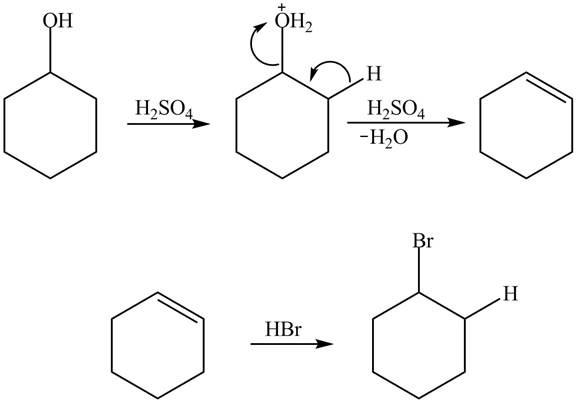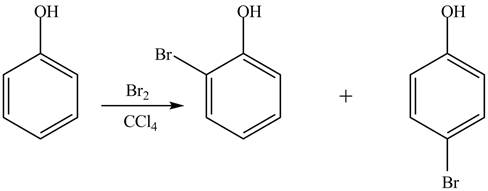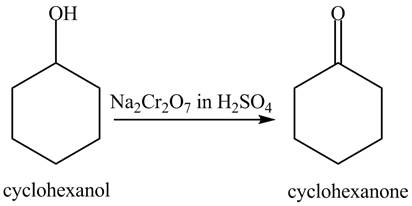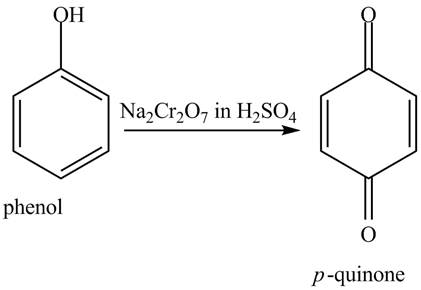
(a)
Interpretation:
The reactivity of cyclohexanol and phenol with aqueous
Concept introduction:
The phenol is an aromatic compound having a formula,
Answer to Problem 18.53AP
Phenol is more reactive than cyclohexanol with an aqueous
Explanation of Solution
The sodium hydroxide is a strong base. It abstracts a proton from the stronger acidic compound and forms its sodium salt. In the given case, sodium hydroxide abstracts a proton from phenol and cyclohexanol and form phenoxide ion and cyclohexanol conjugate base respectively. The phenoxide ion gets stabilized by resonance structures, but this is not possible in case of cyclohexanol conjugate base. It is known that more the stability of the conjugate base more the acidity of the compound. In the given case, phenoxide ion is more stable due to this phenoxide is more acidic. Therefore, phenoxide ion is more reactive toward an aqueous

Figure 1
The reactivity of phenol is more as compared to cyclohexanol with an aqueous solution of
(b)
Interpretation:
The reactivity of cyclohexanol and phenol with
Concept introduction:
The phenol is an aromatic compound having a formula,
Answer to Problem 18.53AP
Phenol is more reactive than cyclohexanol with an aqueous
Explanation of Solution
The sodium hydride is a strong base. It abstracts a proton from the stronger acidic compound and forms its sodium salt and hydrogen gas is evolved. In the given case, sodium hydroxide abstracts a proton from phenol and cyclohexanol and form phenoxide ion and cyclohexanol conjugate base respectively. The phenoxide ion gets stabilized by resonance structures, but this is not possible in case of cyclohexanol conjugate base. It is known that more the stability of the conjugate base more the acidity of the compound. In the given case, phenoxide ion is more stable due to this phenoxide is more acidic. Therefore, phenoxide ion is more reactive toward an aqueous

Figure 2
The reactivity of phenol is more as compared to cyclohexanol with an aqueous solution of
(c)
Interpretation:
The reactivity of cyclohexanol and phenol with triflic anhydride in pyridine at
Concept introduction:
The triflic anhydride is a chemical compound which is also known as Trifluoromethanesulfonic anhydride. It has a molecular formula
Answer to Problem 18.53AP
The presence of the more nucleophilic character of cyclohexanol makes it more reactive towards triflic anhydride in pyridine at
Explanation of Solution
In the given case, when triflic acid reacts with cyclohexanol and phenol in the presence of pyridine at

Figure 3
The reactivity of cyclohexanol is more as compared to phenol with triflic acid in pyridine at
(d)
Interpretation:
The reactivity of cyclohexanol and phenol with concentrated aqueous
Concept introduction:
The phenol is an aromatic compound having a formula,
Answer to Problem 18.53AP
The deactivation of the aromatic ring of phenol makes it less reactive toward concentrated aqueous
Explanation of Solution
Cyclohexanol is more nucleophilic as compared to phenol. It is due to the participation of the lone pair of electrons on oxygen in resonance structures of phenol. Therefore, in the given conditions cyclohexanol reacts more rapidly as compared to phenol. When cyclohexanol undergoes protonation in the presence of

Figure 4
In the case of phenol, it undergoes electrophilic aromatic substitution reaction with
The reactivity of phenol is less with concentrated aqueous
(e)
Interpretation:
The reactivity of cyclohexanol and phenol with
Concept introduction:
The phenol is an aromatic compound having a formula,
Answer to Problem 18.53AP
The phenol is more reactive toward
Explanation of Solution
The phenol is an aromatic compound which shows similar reactions as

Figure 5
Whereas no such reaction is possible with cyclohexanol because this compound gives addition reaction.
The phenol is an aromatic compound which undergoes electrophilic substitution reaction. Due to this, it is more reactive toward
(f)
Interpretation:
The reactivity of cyclohexanol and phenol with
Concept introduction:
Oxidation is defined as the addition of oxygen atom or removal of the hydrogen atom. The oxidizing agent is the substance that causes oxidation and itself get reduced. The reagent
Answer to Problem 18.53AP
The phenol is an aromatic compound which loses its aromatic character on reaction with
Explanation of Solution
In the given conditions, both the given compounds undergo an oxidation reaction. The reaction of cyclohexanol with

Figure 6
The reaction of phenol with

Figure 7
When phenol undergoes oxidation reaction, it loses its aromatic character which means it loses its stability. Therefore, cyclohexanol is more reactive toward
The phenol on reaction with
(g)
Interpretation:
The reactivity of cyclohexanol and phenol with
Concept introduction:
The phenol is an aromatic compound having a formula,
Answer to Problem 18.53AP
The deactivation of the aromatic ring of phenol due to protonation of the hydroxyl group makes it less reactive toward
Explanation of Solution
Cyclohexanol is more nucleophilic as compared to phenol. It is due to the participation of the lone pair of electrons on oxygen in resonance structures of phenol. Therefore, in the given conditions cyclohexanol reacts more rapidly as compared to phenol. When cyclohexanol undergoes protonation in the presence of

Figure 8
The less nucleophilic character makes phenol less reactive toward
The reactivity of phenol is less with
Want to see more full solutions like this?
Chapter 18 Solutions
Organic Chemistry, Ebook And Single-course Homework Access
- Write the systematic name of each organic molecule: structure HO-C-CH2-CH3 O -OH CH3-CH2-CH2-CH2-CH2-C-OH CH3 CH3-CH-CH2-C-OH Explanation Check S namearrow_forwardtheres 2 productsarrow_forwardDraw the major product of this solvolysis reaction. Ignore any inorganic byproducts. + CH3CH2OH Drawing Q Atoms, Bonds and Rings OCH2CH3 || OEt Charges OH 00-> | Undo Reset | Br Remove Done Drag To Pan +arrow_forward
- Draw the major product of this SN1 reaction. Ignore any inorganic byproducts. CH3CO2Na CH3CO2H Drawing + Br Q Atoms, Bonds and Rings OAC Charges OH ОАс Na ဂ Br Undo Reset Remove Done Drag To Pan +arrow_forwardOrganic Functional Groups entifying positions labeled with Greek letters in acids and derivatives 1/5 ssible, replace an H atom on the a carbon of the molecule in the drawing area with a ce an H atom on the ẞ carbon with a hydroxyl group substituent. ne of the substituents can't be added for any reason, just don't add it. If neither substi er the drawing area. O H OH Oneither substituent can be added. Check D 1 Accessibility ado na witharrow_forwardDifferentiate between electrophilic and nucleophilic groups. Give examples.arrow_forward
- An aldehyde/ketone plus an alcohol gives a hemiacetal, and an excess of alcohol gives an acetal. The reaction is an equilibrium; in aldehydes, it's shifted to the right and in ketones, to the left. Explain.arrow_forwardDraw a Haworth projection or a common cyclic form of this monosaccharide: H- -OH H- OH H- -OH CH₂OHarrow_forwardAnswer the question in the first photoarrow_forward
- Ggggffg2258555426855 please don't use AI Calculate the positions at which the probability of a particle in a one-dimensional box is maximum if the particle is in the fifth energy level and in the eighth energy level.arrow_forwardExplain the concepts of hemiacetal and acetal.arrow_forwardBriefly describe a nucleophilic addition.arrow_forward
 Chemistry: Principles and ReactionsChemistryISBN:9781305079373Author:William L. Masterton, Cecile N. HurleyPublisher:Cengage Learning
Chemistry: Principles and ReactionsChemistryISBN:9781305079373Author:William L. Masterton, Cecile N. HurleyPublisher:Cengage Learning Introduction to General, Organic and BiochemistryChemistryISBN:9781285869759Author:Frederick A. Bettelheim, William H. Brown, Mary K. Campbell, Shawn O. Farrell, Omar TorresPublisher:Cengage Learning
Introduction to General, Organic and BiochemistryChemistryISBN:9781285869759Author:Frederick A. Bettelheim, William H. Brown, Mary K. Campbell, Shawn O. Farrell, Omar TorresPublisher:Cengage Learning

